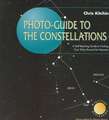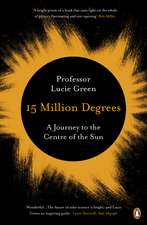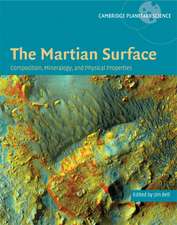Measure Solar System Objects and Their Movements for Yourself!: The Patrick Moore Practical Astronomy Series
Autor John D. Clarken Limba Engleză Paperback – 26 mar 2009
A basic knowledge of geometry is required, but it is amazing how simple the geometry can be. Readers are led through the geometry as gently as possible - and in a light-hearted way - presuming that most non-academics will have half-forgotten most of their mathematics.
The practical astronomical equipment recommended is no more than a typical commercially-made amateur telescope and a camera of some sort - these days a webcam works very well. Apart from that all the reader will need is access to a computer, the know-how to download free software, and an enthusiasm to expand his knowledge of the basis of scientific astronomy.
Din seria The Patrick Moore Practical Astronomy Series
-
 Preț: 258.21 lei
Preț: 258.21 lei -
 Preț: 164.94 lei
Preț: 164.94 lei -
 Preț: 324.21 lei
Preț: 324.21 lei -
 Preț: 255.10 lei
Preț: 255.10 lei - 8%
 Preț: 581.98 lei
Preț: 581.98 lei -
 Preț: 159.16 lei
Preț: 159.16 lei -
 Preț: 282.38 lei
Preț: 282.38 lei -
 Preț: 308.55 lei
Preț: 308.55 lei -
 Preț: 309.87 lei
Preț: 309.87 lei -
 Preț: 332.98 lei
Preț: 332.98 lei -
 Preț: 276.91 lei
Preț: 276.91 lei -
 Preț: 243.94 lei
Preț: 243.94 lei -
 Preț: 183.40 lei
Preț: 183.40 lei -
 Preț: 378.09 lei
Preț: 378.09 lei -
 Preț: 302.20 lei
Preț: 302.20 lei -
 Preț: 210.01 lei
Preț: 210.01 lei -
 Preț: 212.68 lei
Preț: 212.68 lei -
 Preț: 271.39 lei
Preț: 271.39 lei -
 Preț: 252.91 lei
Preț: 252.91 lei -
 Preț: 281.95 lei
Preț: 281.95 lei -
 Preț: 289.85 lei
Preț: 289.85 lei -
 Preț: 218.84 lei
Preț: 218.84 lei -
 Preț: 282.38 lei
Preț: 282.38 lei -
 Preț: 128.86 lei
Preț: 128.86 lei -
 Preț: 301.10 lei
Preț: 301.10 lei -
 Preț: 204.78 lei
Preț: 204.78 lei -
 Preț: 307.44 lei
Preț: 307.44 lei -
 Preț: 303.07 lei
Preț: 303.07 lei -
 Preț: 258.83 lei
Preț: 258.83 lei -
 Preț: 155.25 lei
Preț: 155.25 lei -
 Preț: 193.97 lei
Preț: 193.97 lei -
 Preț: 208.26 lei
Preț: 208.26 lei -
 Preț: 279.09 lei
Preț: 279.09 lei -
 Preț: 303.51 lei
Preț: 303.51 lei -
 Preț: 277.54 lei
Preț: 277.54 lei -
 Preț: 208.51 lei
Preț: 208.51 lei -
 Preț: 214.86 lei
Preț: 214.86 lei -
 Preț: 304.58 lei
Preț: 304.58 lei -
 Preț: 220.57 lei
Preț: 220.57 lei -
 Preț: 157.32 lei
Preț: 157.32 lei -
 Preț: 275.98 lei
Preț: 275.98 lei -
 Preț: 288.98 lei
Preț: 288.98 lei -
 Preț: 261.49 lei
Preț: 261.49 lei -
 Preț: 279.09 lei
Preț: 279.09 lei -
 Preț: 160.82 lei
Preț: 160.82 lei -
 Preț: 327.01 lei
Preț: 327.01 lei -
 Preț: 254.90 lei
Preț: 254.90 lei -
 Preț: 304.38 lei
Preț: 304.38 lei -
 Preț: 256.84 lei
Preț: 256.84 lei
Preț: 208.51 lei
Nou
Puncte Express: 313
Preț estimativ în valută:
39.90€ • 41.77$ • 33.01£
39.90€ • 41.77$ • 33.01£
Carte disponibilă
Livrare economică 17-31 martie
Preluare comenzi: 021 569.72.76
Specificații
ISBN-13: 9780387895604
ISBN-10: 0387895604
Pagini: 173
Ilustrații: XV, 173 p. 80 illus.
Dimensiuni: 155 x 235 x 9 mm
Greutate: 0.34 kg
Ediția:2009
Editura: Springer
Colecția Springer
Seria The Patrick Moore Practical Astronomy Series
Locul publicării:New York, NY, United States
ISBN-10: 0387895604
Pagini: 173
Ilustrații: XV, 173 p. 80 illus.
Dimensiuni: 155 x 235 x 9 mm
Greutate: 0.34 kg
Ediția:2009
Editura: Springer
Colecția Springer
Seria The Patrick Moore Practical Astronomy Series
Locul publicării:New York, NY, United States
Public țintă
Popular/generalCuprins
How Do We Know That Venus Orbits The Sun?.- How Big is the Earth?.- How Far Away and How Big is the Moon?.- Jupiter's Moons: Where You Can Watch Gravity Do Its Thing.- Sunrise, Sunset.- Getting Further from the Sun: How do you Ride an Epicycle?.- Size Matters.
Recenzii
From the reviews:“This delightful book … is really a breath of fresh air in popular science publishing, taking us back to astronomical basics and starting from the beginning. With the help of very clear diagrams and graphics, the text takes you through fully-worked examples, asking questions about sizes, distances and motions within the Solar System. It then sets about, always with simple, readily available and inexpensive equipment, to show you how to answer those questions for yourself. … Overall, this is a very worthwhile text … .” (John Rowlands, Astronomy Now, January, 2010)
Notă biografică
John Clark holds a Bachelor of Science, first class honors, in Physics, from London University, England, and a Ph. D. in Physics from Warwick University, England. He is a Fellow of the Institute of Physics, and spent two years as a post-doctoral researcher at Case Western Reserve University in the USA. Currently he is Managing Director of Fine R and D Limited. He has been an active amateur astronomer for many years.
Textul de pe ultima copertă
Instead of taking somebody's word about the basic size and distances for the solar system's objects, this book shows amateur astronomers how to measure these things for themselves. This is an enriching experience for any amateur astronomer - to understand and personally measure fundamental astronomical quantities and distances.
A basic knowledge of geometry is required, but it is amazing how simple the ideas can be. Readers are led through the details as gently as possible - and in a light-hearted way - presuming that most will have half-forgotten most of the mathematics.
The practical astronomical equipment recommended is no more than a typical commercially-made amateur telescope and a camera of some sort - these days a webcam works very well. Apart from that all the reader will need is access to a computer with internet service, the know-how to download free software, and an enthusiasm to expand his knowledge of the basics of scientific astronomy.
A basic knowledge of geometry is required, but it is amazing how simple the ideas can be. Readers are led through the details as gently as possible - and in a light-hearted way - presuming that most will have half-forgotten most of the mathematics.
The practical astronomical equipment recommended is no more than a typical commercially-made amateur telescope and a camera of some sort - these days a webcam works very well. Apart from that all the reader will need is access to a computer with internet service, the know-how to download free software, and an enthusiasm to expand his knowledge of the basics of scientific astronomy.
Caracteristici
Shows amateur astronomers how they can measure planetary sizes and distances for themselves, as well as orbital speed Improves the reader's appreciation and perspective of what he or she might see and image in the sky A small step (but also a giant leap) into astrometry written in an entertaining, anecdotal style Measurements require simple math early on and more subtle concepts appear only towards the final chapters










